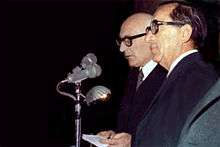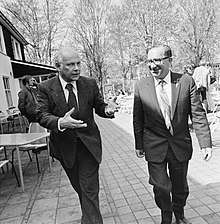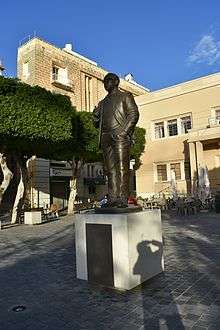Dom Mintoff
Dominic Mintoff, KUOM (Maltese: Duminku Mintoff; often called il-Perit, "the Architect"; 6 August 1916 – 20 August 2012)[1] was a Maltese Socialist politician, architect, anti-colonialist revolutionary, and civil engineer who was leader of the Labour Party from 1949 to 1984, and was 8th Prime Minister of Malta from 1955 to 1958, when Malta was still a British colony, and again, following independence, from 1971 to 1984.[2] His tenure as Prime Minister saw the creation of a comprehensive welfare state, nationalisation of large corporations, a substantial increase in the general standard of living and the establishment of the Maltese republic,[3][4][5] but was later on marred by a stagnant economy, a rise in authoritarianism and outbreaks of political violence.[6][7][8][9]
Dom Mintoff | |
|---|---|
.jpg) | |
| 8th Prime Minister of Malta | |
| In office 21 June 1971 – 22 December 1984 | |
| Monarch | Elizabeth II |
| President | Anthony Mamo Anton Buttigieg Albert Hyzler (Acting) Agatha Barbara |
| Governor-General | Maurice Henry Dorman Anthony Mamo |
| Preceded by | Giorgio Borg Olivier |
| Succeeded by | Karmenu Mifsud Bonnici |
| In office 11 March 1955 – 26 April 1958 | |
| Monarch | Elizabeth II |
| Governor | Robert Laycock |
| Preceded by | Giorgio Borg Olivier |
| Succeeded by | George Borg Olivier (1962) |
| Personal details | |
| Born | 6 August 1916 Bormla, Malta |
| Died | 20 August 2012 (aged 96) Tarxien, Malta |
| Political party | Labour Party |
| Spouse(s) | Moyra de Vere Bentinck
( m. 1947; died 1997) |
| Children |
|
Early life and education
Mintoff was born on 6 August 1916, and was baptised in his hometown Bormla.[10] His father was a naval cook and his mother a money lender.[11] He attended a seminary before enrolling at the University of Malta. He graduated with a Bachelor of Science and, later, as an architect and civil engineer (1937). That same year he received a Rhodes Scholarship and pursued his studies at Hertford College, Oxford, where he received a Masters in Science and Engineering in 1939.[11]
Political career
Early political career (1935–1949)
After a brief stint as an official of the Bormla Labour Party club, Mintoff was Labour's Secretary General between 1935 and 1945 (resigning briefly to pursue his studies abroad). He was first elected to public office in 1945 to the Government Council. In the same year, Mintoff was elected Deputy Leader of the Party with a wide margin that placed him in an indisputable position as the successor, if not a challenger, to party leader Paul Boffa. After Labour's victory at the polls in 1947, Mintoff was appointed Deputy Prime Minister and Minister of Public Works and Reconstruction, overseeing large post-War public projects.[7]
Leader of the Labour Party (1949–1984)

- First two mandates
Mintoff's strong position and ambition led to a series of Cabinet crises. A split in the Labour Party came about when Boffa, who was ready for compromise and moderation with the colonial authorities, resigned and formed the Malta Workers Party and Mintoff refounded the Labour Party as the "Malta Labour Party" of which he assumed leadership. The split resulted in the weakening of both parties and it was not until 1955 after remaining out of government for three consecutive legislatures, that the Labour Party was elected to office with Mintoff as Prime Minister. This government's main political platform – integration with the UK – led to a deterioration of the Party's relations with the Catholic Church, leading to interdiction by the Church which resulted in voting Labour being declared a mortal sin leading all who defied the Church to be informally known as "Suldati tal-Azzar" (Soldiers of Steel). The Labour Party lost the subsequent two elections in 1962 and 1966 and boycotted the Independence celebrations in 1964 due to disagreements with the Independence agreements which still gave a good amount of power to the British Government.[5]
Following the lift of the interdiction in 1964, and the improvement of relationship with the Catholic Church in 1969, Dom Mintoff was elected as Prime Minister when Labour won the 1971 general election and immediately set out to re-negotiate the post-Independence military and financial agreements with the United Kingdom. The government also undertook socialist-style nationalization programmes, often in breach of property rights,[9] import substitution schemes, and the expansion of the public sector and the welfare state. Employment laws were revised with gender equality being introduced in salary pay. In the case of civil law, civil (non-religious) marriage was introduced and sodomy, homosexuality and adultery were decriminalised. Through a package of constitutional reforms agreed to with the opposition party, Malta declared itself a republic in 1974.[12] In 1979, the last of the British Naval Troops left Malta.
- Social and political troubles in the 1980s
The Labour Party was confirmed in office in the 1976 elections. In 1981, amid allegations of gerrymandering, the Party managed to hold on to a parliamentary majority, even though the opposition Nationalist Party managed an absolute majority of votes.[13] A serious political crisis ensued when Nationalist MPs refused to accept the electoral result and also refused to take their seats in parliament for the first years of the legislature. Mintoff called this action "perverse" but it was not an uncommon one in any parliamentary democracy with disputed election results. He proposed to his parliamentary group that fresh elections be held, but most members of his Parliamentary group rejected his proposal. Mintoff stayed on as prime minister until 1984, during which time he suspended the Constitutional Court.[14] He resigned as Prime Minister and Party leader aged 68 in 1984 (although he retained his parliamentary seat), opening the way for his deputy prime minister Karmenu Mifsud Bonnici to succeed him.[13]
For the 1981 elections, the opposition Nationalist Party, reinvigorated with a new leader, looked set for a serious challenge to Mintoff. In fact, in that election, the Partit Nazzjonalista managed an absolute majority of votes, but managed only 31 seats to the Malta Labour Party's 34. Mintoff said that he would not be ready to govern in such conditions and hinted that he would call for fresh elections within six months. However, pressure from party members forced Mintoff to do otherwise: Mintoff eventually accepted the President's invitation to form a government. This led to a political crisis whose effects continued through much of the 1980s characterised by mass civil disobedience and protests led by Opposition Leader Eddie Fenech Adami as well as increasing political violence in the street as a result such as the Black Monday incident.
Labour backbencher (1984–1998)
Mintoff resigned as Prime Minister and Leader of the Labour Party in 1984, while retaining his Parliamentary seat and remaining a government backbencher. He was succeeded by Karmenu Mifsud Bonnici. Mintoff was instrumental in convincing his parliamentary colleagues to support constitutional amendments ensuring a parliamentary majority for the party achieving an absolute majority of votes. A repeat of 1981 was thus avoided, and the Partit Nazzjonalista went on to win the 1987 elections. The Labour Party went into opposition for the first time in sixteen years. He successfully contested the 1987 and 1996 elections. However, there was a growing rift between Mintoff, seen as Old Labour, and Alfred Sant, the new Labour Leader. Things came to a head in 1998 when the Labour government was negotiating the lease of sealine to be developed in a yacht marina in Birgu. Mintoff eventually voted against the government's motion which was defeated. The Prime Minister saw this as a loss of confidence and The President, acting on Prime Minister Sant's advice dissolved Parliament and elections were held. This was the first time, since the war, that Mintoff's name was not on the ballot paper and the Malta Labour Party lost heavily. [15]
Foreign policy

After Mintoff's initial attempts at integration with Great Britain proved unsuccessful he resigned in 1958 and became a strident advocate of decolonisation and independence.[16] Returning to office in 1971, he immediately set about renegotiating Malta's defence agreement with Britain.[16] The difficult negotiations with Britain, which later resulted in the departure of British forces in 1979 and the attendant losses in rent, were coupled with a policy of Cold War brinkmanship which saw Mintoff seek to play rivals off each other and look increasingly east and south, courting Mao Zedong, Kim Il-sung, Nicolae Ceaușescu and Muammar Gaddafi.[11]
Recently declassified CIA reports show US fears that a Mintoff-led government in Malta could see the country fall under the Soviet sphere of influence. The reports also show that the US was planning to rig the Maltese election in favour of the opposition in order to bring down Mintoff's government.[17]
Mintoff opposed Malta's EU and eurozone membership on the concern for Malta's status as a constitutionally neutral country.[18]
Post-retirement (1998–2012)
After his retirement from parliamentary politics, Mintoff's involvement in public life was only occasional. He made some appearances in the referendum campaign on Malta's membership to the EU and, with Alfred Sant being replaced in 2008, some rapprochement with Labour was made.
Personal life
On 22 November 1947, Mintoff married Moyra de Vere Bentinck (12 July 1917 – 16 December 1997)[19][20][21][22][23] The couple got married at the parish church of Bir id-Deheb, Our Lady of Mercy, in Żejtun.[24] He met her during his studies in Oxford. The couple had two daughters, Anne and Yana. Yana, a member of the Socialist Workers Party, acquired brief notoriety in 1978 when she bombed the chamber of the UK House of Commons with manure in a protest against the British military presence in Northern Ireland.[13]
Death
Mintoff was taken to hospital on 18 July 2012.[25] He was later discharged on 4 August and spent his 96th birthday at home[26][27] where he died on 20 August.[28] He was given a state funeral by the Government of Malta on 25 August.[29]
Legacy

While generations of loyal supporters continue to credit Mintoff with the introduction of social benefits like the children's allowance, two-thirds pensions, minimum wage and social housing as well as the creation of Air Malta, Sea Malta, the separation of church and state and ending 200 years of British Colonial rule, critics point to his divisive legacy and the violence and unrest that characterised his time in office. It has also been pointed out by Mintoff's critics that a pervasive cult of personality has been maintained after his death, most prominently within the Labour Party.

A statue of Mintoff was unveiled in his hometown Cospicua on 12 December 2014. The monument was designed by the artist Noel Galea Bason.[30]
In 2013, the main square in front the church of Our Lady of Mercy in Bir id-Deheb, Żejtun was renamed Dom Mintoff Square.
In March 2016, Corradino Road (Maltese: Triq Kordin) in Paola was renamed Dom Mintoff Road (Maltese: Triq il-Perit Dom Mintoff).[31]
In August 2017, a project was launched to convert a large green area in the town of Paola into a park called the "Dom Mintoff Gardens".
In May 2018, another statue of Mintoff was unveiled in Castille Square in Valletta directly opposite the office of the Prime Minister.
Honours
- Companion of Honour of the National Order of Merit (1990) by right as a former Prime Minister of Malta
- Al-Gaddafi International Prize for Human Rights (2008)[32]
- Order of the Republic of Libya (1971)
- Grand Cordon of Tunisia (1973)
- Moroccan Order of Ouissam Alaouite (1978)[33]
References
- Cyprus, Greece, and Malta. Britanncia Educational Publishing. 1 June 2013. Retrieved 9 May 2018 – via Google Books.
- Dom Mintoff. Encyclopædia Britannica. Retrieved 20 February 2010.
- Briguglio, Michael (October 2001). "3". The Malta Labour Party in Perspective: 1920-87 (PDF) (Sociology M.A.). University of Malta. Archived from the original (PDF) on 27 February 2012. Retrieved 25 August 2013.
- Carmen Sammut (2007). Media and Maltese Society. Lexington Books. p. 35. ISBN 9780739115268. Retrieved 20 August 2012 – via Books.google.com.
- "Dom Mintoff, Malta's political giant, passes away". Times of Malta. Retrieved 19 August 2016.
- "Dom Mintoff". 21 August 2012. ISSN 0307-1235. Retrieved 18 February 2018.
- "Dom Mintoff, a dominant figure in Malta for 30 years, did great harm to his country". Catholic Herald. 22 August 2012. Retrieved 18 February 2018.
- "CIA Files Show 20 Years Of Paranoia About Dom Mintoff". Retrieved 18 February 2018.
- "Court finds in favour of National Bank shareholders". The Malta Independent. Retrieved 18 February 2018.
- https://www.academia.edu/8007251/Il-Perit_Duminku_Mintoff_u_l-Immakulata_1916-2012
- McFadden, Robert D. (20 August 2012). "Dom Mintoff, Proponent of Maltese Independence, Dies at 96". The New York Times. ISSN 0362-4331. Retrieved 18 February 2018.
- Monarchy and the End of Empire: The House of Windsor, the British Government, and the Postwar Commonwealth, Philip Murphy, OUP Oxford, 2013, page 157
- Patterson, Moira (21 August 2012). "Dom Mintoff obituary". The Guardian. Retrieved 18 February 2018.
- Ltd, Allied Newspapers. "How the Constitutional Court betrays Malta's Constitution". Times of Malta. Retrieved 18 February 2018.
- "Malta changes its mind, again". The Economist. 10 September 1998. ISSN 0013-0613. Retrieved 15 May 2020.
- "Obituary: Dom Mintoff". BBC News. 21 August 2012. Retrieved 18 February 2018.
- "The Outlook for an Independent Malta" (PDF). Central Intelligence Agency. Retrieved 18 February 2018.
- "Dom Mintoff: Pugnacious Prime Minister of Malta who fought for". The Independent. 23 August 2012. Retrieved 18 February 2018.
- Current World Leaders. International Academy at Santa Barbara. 9 May 1980. Retrieved 9 May 2018 – via Google Books.
- "Moyra de Vere Mintoff". geni_family_tree. Retrieved 9 May 2018.
- "Person Page". thepeerage.com. Retrieved 9 May 2018.
- Charles Mosley, editor, Burke's Peerage, Baronetage & Knightage, 107th edition, 3 volumes (Wilmington, Delaware, U.S.A.: Burke's Peerage (Genealogical Books) Ltd, 2003), volume 3, page 3183
- "Dom Mintoff". The Daily Telegraph. 21 August 2012. Retrieved 19 August 2016.
- "Tal-Hniena-Zejtun". Kappellimaltin.com. Archived from the original on 1 July 2016. Retrieved 19 August 2016.
- "Dom Mintoff's health condition 'improved remarkably' - Mater Dei". Malta Today. 26 July 2012. Retrieved 26 July 2012.
- "Dom Mintoff discharged from Mater Dei Hospital on Saturday". gozonews.com. 5 August 2012. Retrieved 5 August 2012.
- Xuereb, Matthew (5 August 2012). "Mintoff to spend his 96th birthday quietly at home". Times of Malta. Retrieved 5 August 2012.
- "Dom Mintoff, Malta's political giant, passes away". Times of Malta. 20 August 2012. Retrieved 20 August 2012.
- "State funeral for Dom Mintoff". Times of Malta. 20 August 2012. Retrieved 20 August 2012.
- "Dom Mintoff's monument unveiled in Cospicua by Prime Minister Joseph Muscat". The Malta Independent. 12 December 2014. Retrieved 30 March 2016.
- "Corradino Road becomes Dom Mintoff Road, Gaddafi Gardens renamed". Times of Malta. 30 March 2016. Retrieved 30 March 2016.
- "List of recipients of the International Prize for Human Rights". algaddafi.org. Archived from the original on 9 March 2014. Retrieved 19 February 2018.
- "Dom Mintoff". 21 August 2012. ISSN 0307-1235. Retrieved 19 February 2018.
External links
- U.S. Navy wanted to kill Mintoff, The Malta Independent, January 26, 2008.
- The New York Times report of his death
| Political offices | ||
|---|---|---|
| Preceded by Giorgio Borg Olivier |
Prime Minister of Malta 1955–1958 |
Vacant Title next held by Giorgio Borg Olivier |
| Prime Minister of Malta 1971–1984 |
Succeeded by Karmenu Mifsud Bonnici | |
| Party political offices | ||
| Preceded by Paul Boffa |
Leader of the Labour Party 1949–1984 |
Succeeded by Karmenu Mifsud Bonnici |